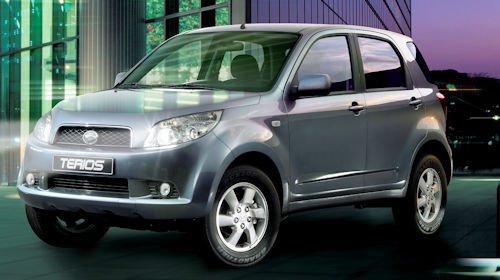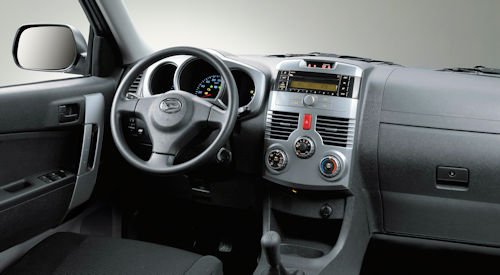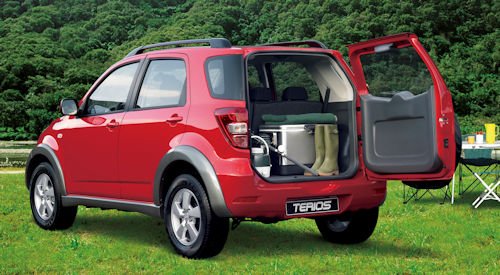Daihatsu Terios 2nd Generation
 |
|
|
Production period: |
2006 to 2017 |
|
Body versions: |
station wagon |
|
Engines: |
Gasoline :1.5 litres |
|
Length: |
4095 mm |
|
Width: |
1695 mm |
|
Height: |
1740 mm |
|
Wheelbase: |
2580 mm |
|
Curb weight: |
1170-1235 kg |
In 2006, a successor model was presented, which was developed in cooperation with Toyota. The new Terios is also sold as Toyota Rush and Daihatsu Be‣go. In early 2009, the second generation of the Terios received a facelift, in which the front, especially the grille, and the tail lights were changed.
The all-new Terios is a fully updated compact SUV. The 2nd gen Terios delivers seemingly contradicting goals of genuine sport utility performance and ease of use in town and provides a stylish presence in whichever situation it is used. Combining the SUV's power, nimble drivability on any road surface, and excellent manoeuvrability in town, the new Terios proposes a new concept compact SUV that can be used stylishly in any situation. Featuring a long wheelbase and super short overhangs two of the most important elements of this car's styling. Specifically, a rounded front bumper and rearward extended headlamps are employed to make the front overhang look shorter and lighter.
The D pillar in the rear is concealed by the quarter window, giving a lighter finish to the rear overhang. These meticulous design works from the front to the rear further emphasise the large wheels and tyres that firmly support the vehicle at the four corners of the body and give the car a big-boned presence without resorting to gimmicky techniques.
The second objective is to express the powerful image of the SUV. The eye-catching wheel flares at the four corners of the body, the sturdy looking door sections and the prominent front styling all contribute to the new Terios's powerful SUV image. The third objective is to give the car a sense of urban sophistication that matches the product concept. The powerfully curved bonnet and headlamps and the flowing, animated cabin styling.

The interior is designed to create the "feel excited" atmosphere that users expect from the SUV. Instead of the "rugged" feel frequently seen in the interiors of traditional SUV. The combination of the long wheelbase and super short overhangs contribute not only to the futuristic proportions of the body but also to the comfortable interior and sophisticated ease of use. In order to seat five adults in comfort and realise packaging that allows generous luggage capacity, Daihatsu's designers studied a variety of situations in which the previous model was used. The conclusion they reached was that the new Terios's couple distance and tandem distance had to be significantly improved and its luggage-compartment length extended by 13 cm compared with its predecessor. To realise an SUV that's also a convenient everyday tool, the new Terios also features a versatile seating arrangement, flat and wide luggage compartment, and ample storage space that effectively takes advantage of the entire cabin space. A combination of tilt steering, seat-height adjuster, shoulder-anchor adjuster and long front-seat slide allows the driver to assume the best driving position tailored to his physique. Excellent forward visibility thanks to the high eye point and a small turning circle of 9.8 metres (kerb to kerb) also make driving easy.
The Terios's power unit is a newly developed 1.5-litre engine Its rich torque in the low to medium rev range promises quick acceleration from standstill and easy overtaking at high speeds. The Terios comes standard with full time 4WD with a centre differential, allowing the driver to drive on the highway, rough terrain or slippery road surfaces with confidence.
In order to improve occupant safety, the Terios employs a safety body structure with increased cabin strength and a variety of safety features including SRS curtain shield airbags, soft upper interior and an airbag-cutoff switch. The Terios also employs VSC (Vehicle Stability Control), which controls the vehicle's
movements in all directions, improving safety in quick cornering and on slippery roads.
AT (automatic transmission) models with VSC come standard with DAC (Down Assist Control) and HAC (Hill-start Assist Control).
By the end of 2014, the model has since not been offered in Europe.

Technical
-
Dimensions
Overall length mm 4055 (4075 with wheel flares)
Overall width mm 1695 (1745 with wheel flares)
Overall height mm 1690 (1740 with roof rails)
Wheelbase mm 2580
Track (front) mm 1450
Track (rear) mm 1480
Ground clearance mm 200
Seating capacity 5Engine
Engine type 3SZ, petrol, 4 cylinder, 16 valve, DOHC, DWT
Displacement 1495
Bore X stroke 72 x 91.8
Max. output kW/rpm 77/6000
Max. torque N•m/rpm 140/4400
Compression ratio 10.0Suspension
Suspension (front) MacPherson-struts with coil springs
Suspension (rear) 5-link rigid axle with coil springsBrakes
(front) Disc brakes with booster
(rear) Drum brakes, leading and trailingTyre size
215/65R16 - 235/60R16Technical data
1.5 2WD
1.5 4WD
Construction period
2006-2017
engine type
R4 gasoline engine
capacity
1495 cc
compression ratio
10.0: 1
Max. Power at min -1
75 kW (102 hp) / 6000
Max. Torque at rpm
140 Nm / 4400
drive
rear-wheel drive
all wheel drive
Gearbox, standard
5-speed manual transmission
Gear, optional
[4- speed automatic transmission]
top speed
160 km / h
[150 km / h]Acceleration, 0-100 km / h
11.8 s
12.4 s
[14.0 s]Fuel consumption per 100 km (combined)
7.2 l super
7.7 l super
tank capacity
50 l
© Motor car History
